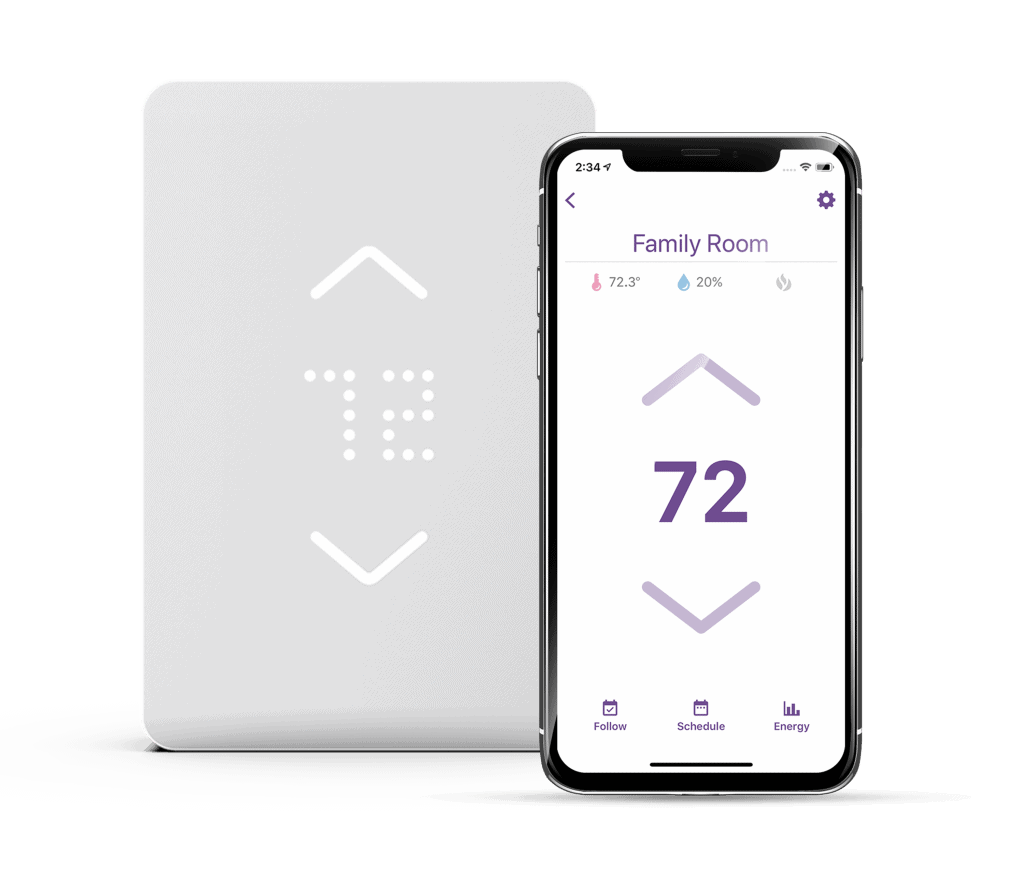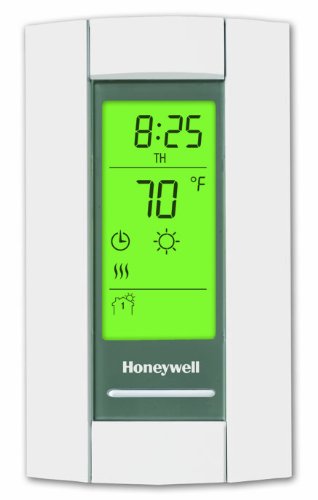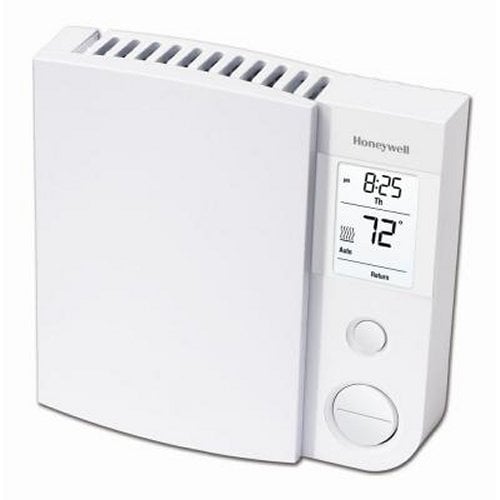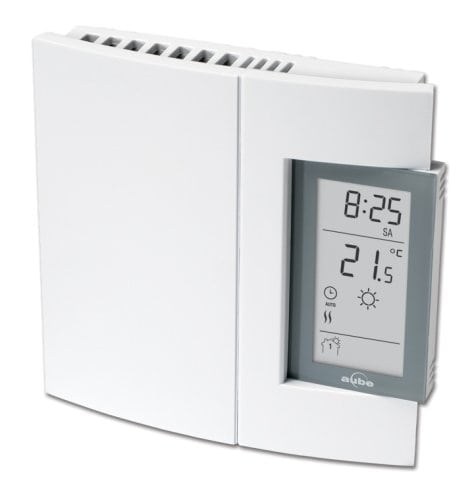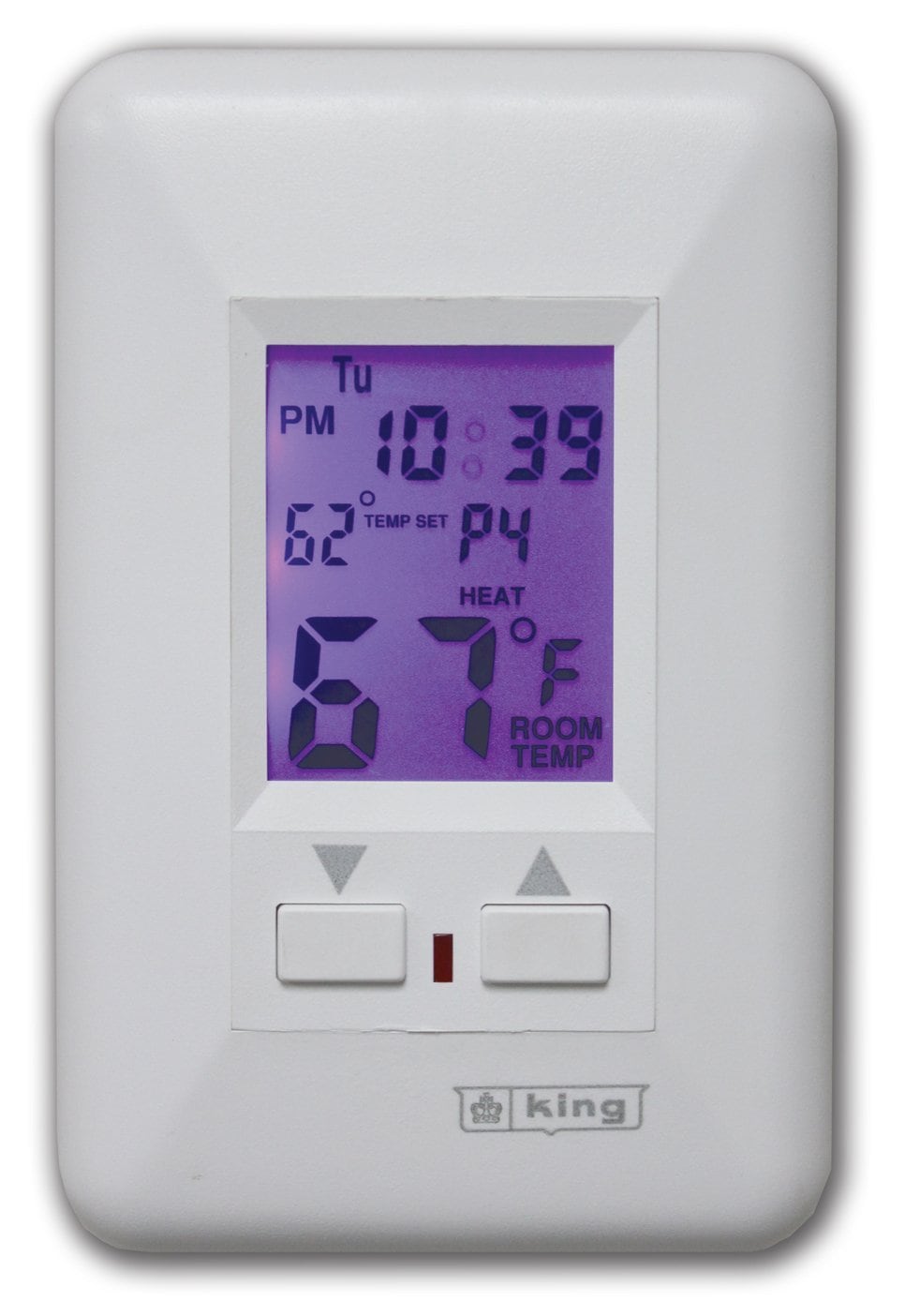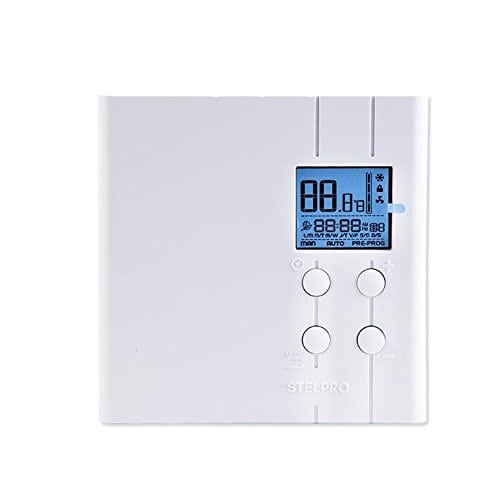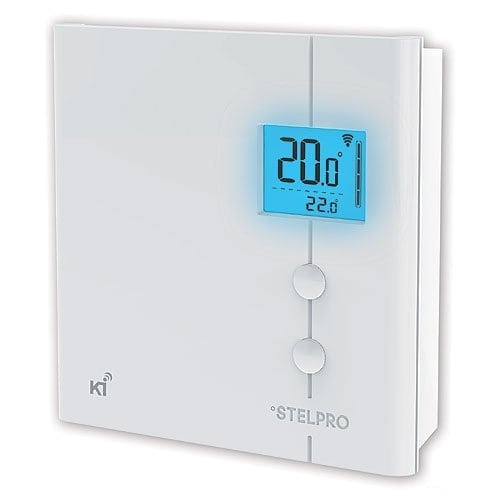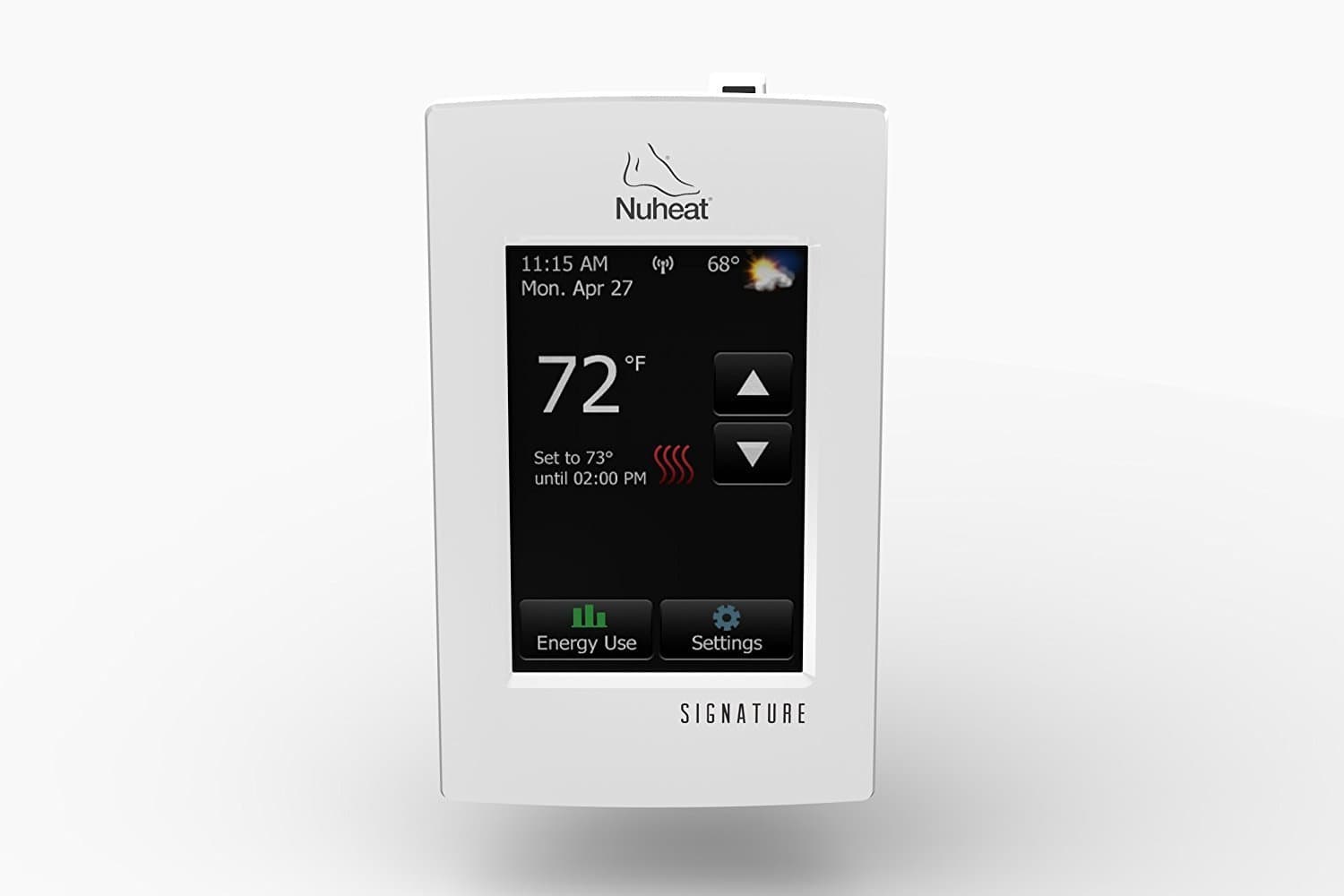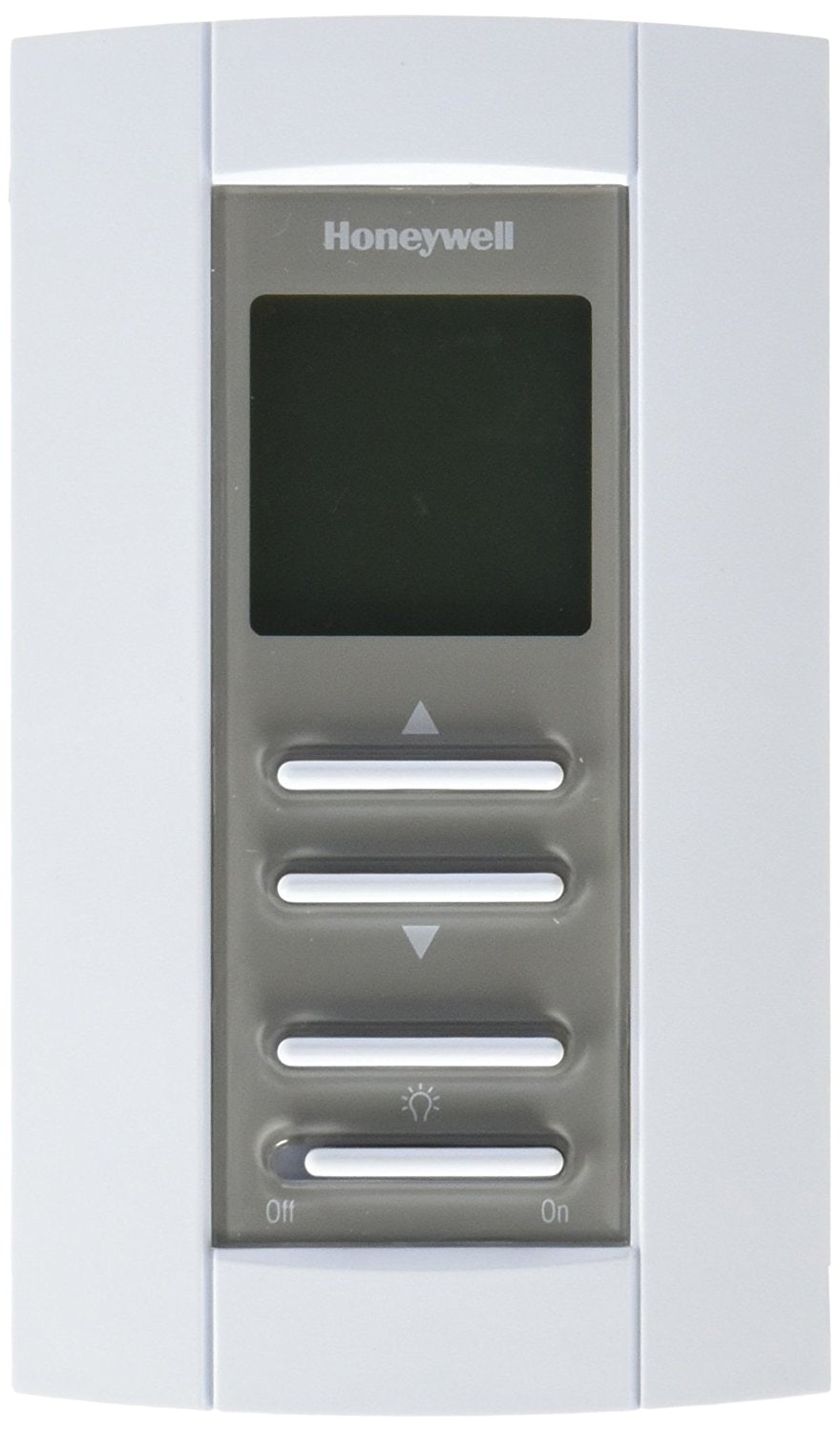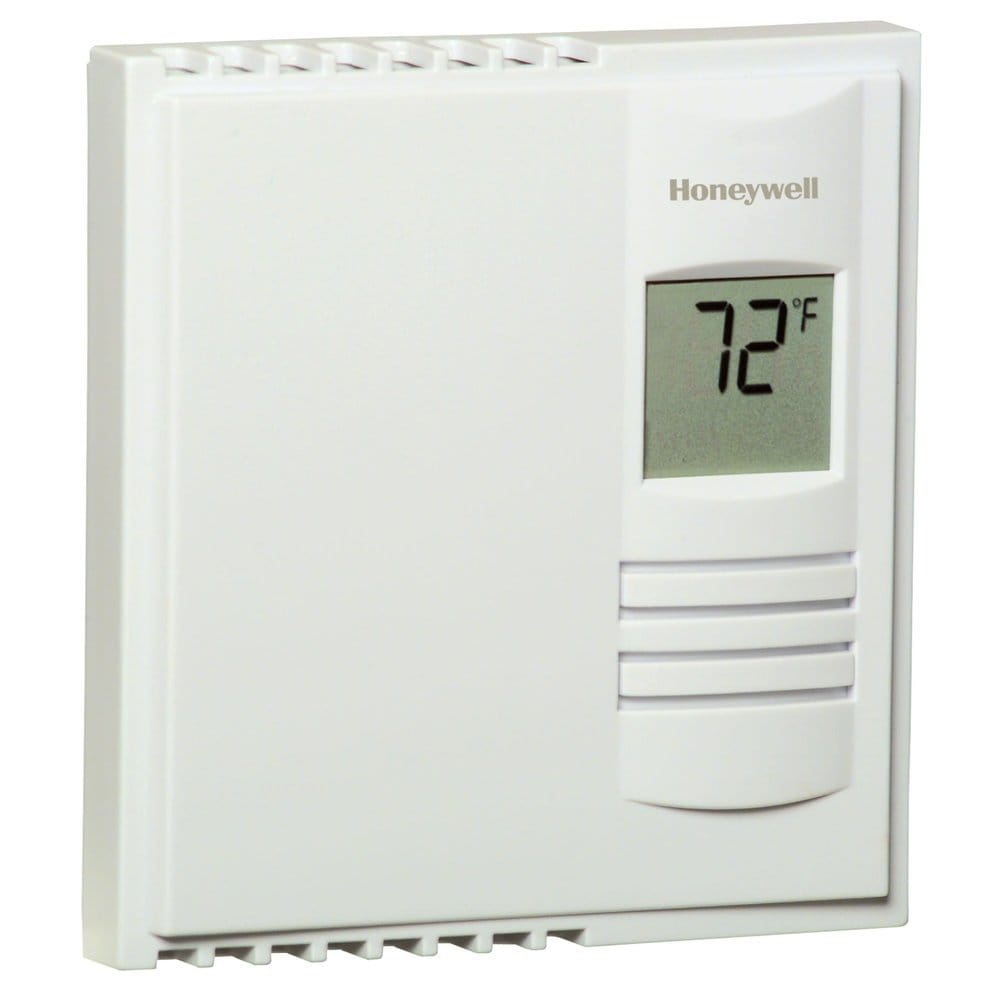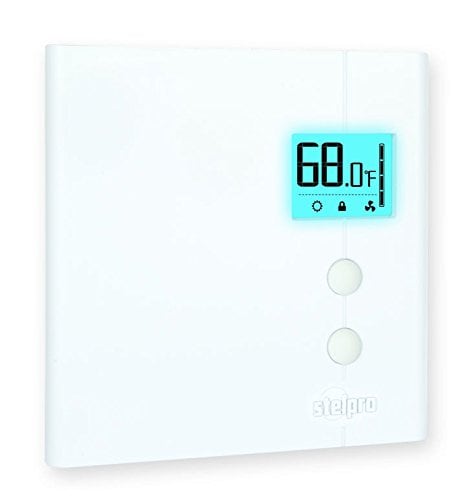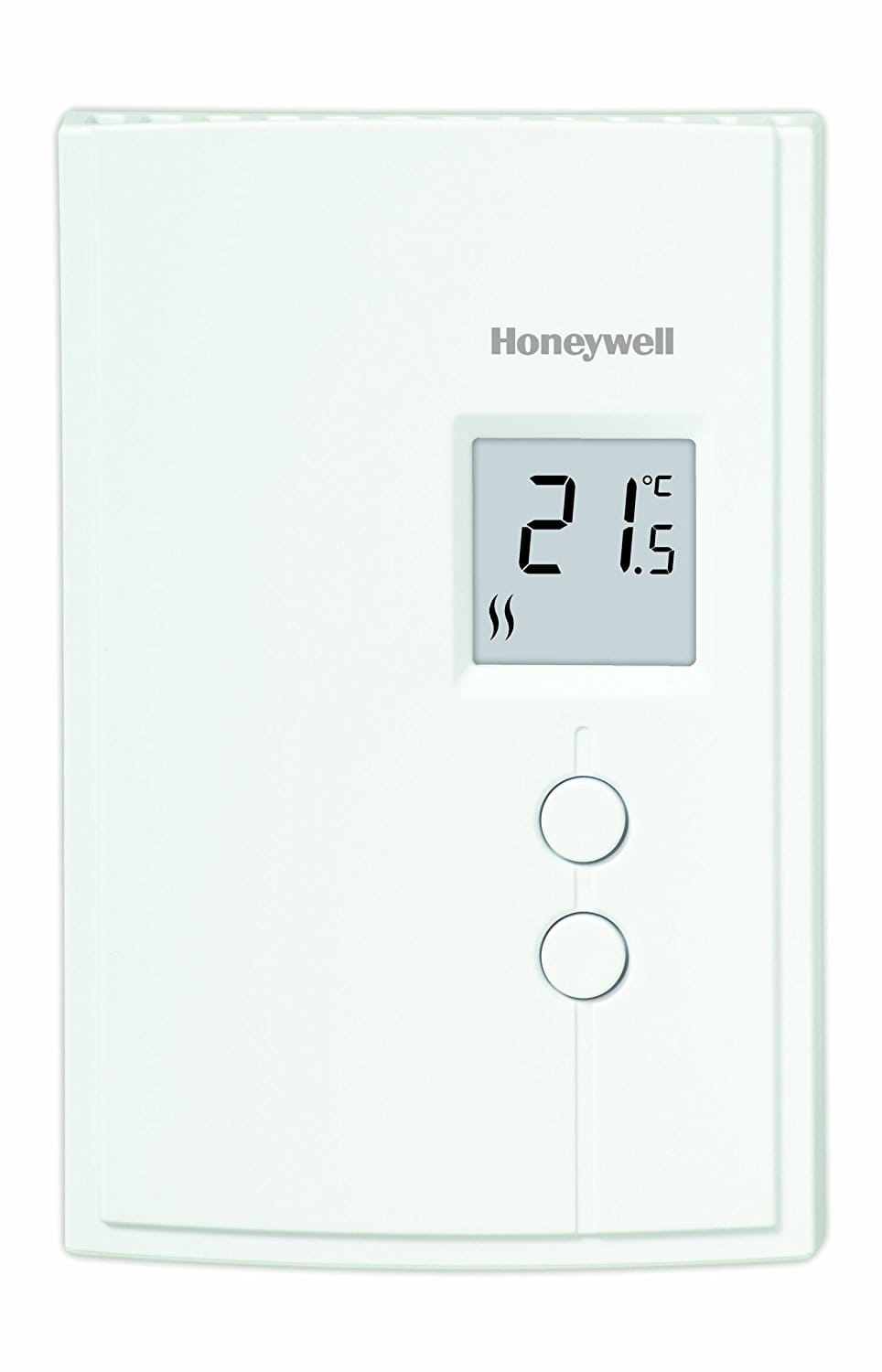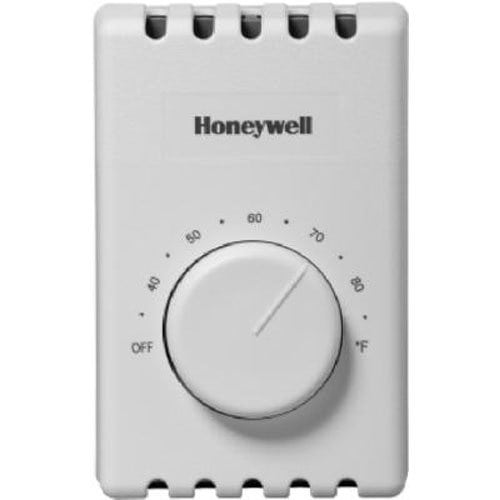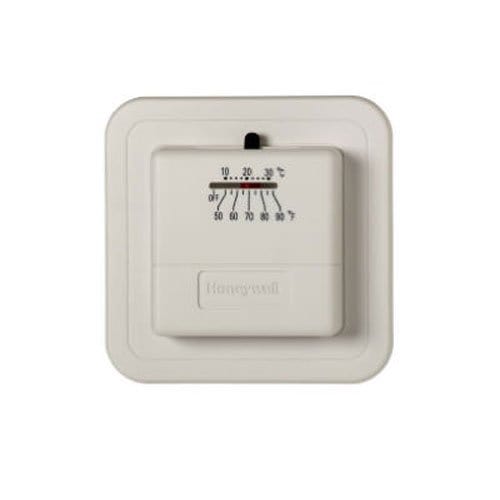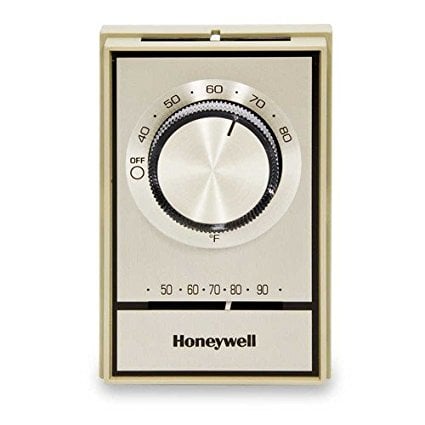Line voltage thermostats are used to regulate heating/cooling systems that run on direct electricity (line voltage – 120 volts or 240 volts). A classic example is baseboard heaters which operate on line voltage. We’ve reviewed baseboard heater thermostat models in our previously published guide. Line voltage thermostats are usually known in different names like line thermostats, inline thermostats, high voltage thermostats, 120 volts/240 volts thermostats, single pole/double pole thermostats or 2 wire/4 wire thermostats. All these different names refer to the same one type – line voltage thermostat. In this guide, we help you to identify your heating/cooling system and choose a line voltage thermostat model that best suits your heating system.
What is Line Voltage Thermostat?
A Line voltage thermostat (or a high voltage thermostat) – runs on direct line voltage (In America, this is either 120 volts or 240 volts). And this thermostat is used to regulate heating systems that work on direct electricity like a baseboard heater. A line volt thermostat usually has thick wires ( two or four wires) coming out of its back, hence they are also known as 2 wire thermostats (single pole) or 4 wire thermostats (double pole). You may read our article on single pole vs double pole thermostats to identify which type is yours, if you already have a thermostat at home.
A line volt thermostat is installed in series with the heating system at line voltage. They operate by switching the mains power to the heating system ON/OFF intermittently, according to the temperature settings. When a room/space attains the desired temperature, the heating system is turned OFF. The heating system will be turned ON again, when the temperature falls below the set point.
The figure below shows a typical high voltage thermostat, with its wires coming out of its back.
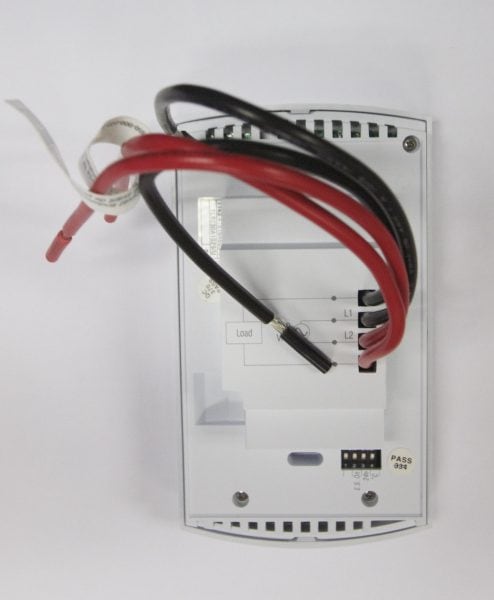
Did You Check Compatibility ?
You’ve to check the compatibility with your heating system before you buy any line voltage thermostat model. A high voltage thermostat should be used for the following type of heating systems.
- Baseboard heaters (or any type of resistance heaters)
- Forced Fan Heaters & Convectors
- Radiant Ceiling Heaters
If you’re unsure of your heating system type, there’s an easy way to identify it. You just need to check the backside of your current thermostat. If you’re having a line voltage system, your thermostat will have 2 or 4 thick wires coming out of its backside. If your thermostat has more than 4 wires, your system is not line voltage type. You will be having a low voltage system in such a case.
Line Voltage or Low Voltage Thermostat
Now you’ve a clear idea about line voltage thermostats and where should you use them (the type of heating system). Do you still get confused between a low voltage and line voltage thermostat? A low voltage thermostat (like Nest, Ecobee, Emerson Sensi) is used for heating/cooling systems like a central furnace, or a boiler – which runs on fuels like oil, natural gas, propane or some other fuel sources. Heat pumps also use low voltage thermostats. So just as the name say, a low voltage thermostat runs on low voltage – that is 24 volts. And they are not compatible with any heating system that runs on direct electricity or line voltage.
Note:- In any case, please note that a low voltage thermostat is not suitable for appliances like baseboard heater, electric room heater, radiant heater, forced fan heater etc. You should specifically buy a line voltage thermostat for these appliances mentioned. Keep that noted.
Smart Line Voltage Thermostats
There was no proper “smart thermostat” for line voltage systems until recently released models like MySa put an end to this. In USA, only about 10% of homes rely on line voltage systems for their heating needs. This small market size might be one reason, which held back companies from making innovative smart high voltage thermostats. When bigger names like Honeywell just went along with their conventional models, new entrants like MySa found this an opportunity to make a name for themselves. Let’s see more about WiFi enabled line voltage smart thermostats.
MySa – Smart Thermostat for Line Volt Systems
MySa – is a proper line voltage smart thermostat by all means. If you compare against low voltage smart models like Nest or Ecobee, the only core feature lacking in MySa is “self learning”. MySa houses all essential features of a smart thermostat like Energy savings, Energy reports (on mobile app), WiFi connectivity, Control from anywhere using mobile app, Voice control using smart hub integrations (with Alexa, Homekit, Google Assistant, Samsung and more), Capacitive touch screen, Mobile app based scheduling, Vacation mode and many other required basic features.
MySa is WiFi enabled, and is arguably the best line voltage WiFi thermostat currently available.
MySa is compatible with all line voltage/high voltage systems like baseboard heaters, convectors (short cycle), fan-forced heaters (long cycle), and radiant ceiling heating. If you’re looking for a high voltage smart thermostat, you should definitely go for MySa – as it is the best choice available currently.
Digital Line voltage Thermostats:
Digital Line Voltage Thermostats – as their name suggests use digital temperature sensing for precise temperature control. You can set or alter temperature much easily in a digital thermostat. And the device will automatically monitor the temperature within 1 degree or less precision of your set point. A digital line voltage thermostat usually comes in 3 different versions – Programmable, WiFi enabled, and Non-Programmable.
Out of the 3 different types, people usually prefer the “programmable line volt thermostat model” or the modern “WiFi line voltage thermostat”. Both of them are basically programmable thermostats, where the “WiFi” variant has the advantage of wireless connectivity. You can control a WiFi thermostat via internet using your smartphone.
Programmable Line Voltage Thermostats:
If you’ve energy savings in mind, you should go for a programmable thermostat. Moreover, programmable thermostats comes with preset programs/schedules which manages your heating requirements so well. You can also program them manually based on your choice/lifestyle.
#1 – Honeywell – 7 Day Programmable Line Volt Thermostat
Honeywell TL8230A1003 – is a 7 Day Programmable line volt thermostat, which can give you an energy savings of 10% on your heating bills. You can program this model for 7 different days (of the week) based on your lifestyle. This Honeywell model also comes with preset schedules/programs – which are carefully programmed to give you the best possible energy savings. Honeywell claims upto 20% of energy savings (if you follow preset schedules), but that could be an ideal case value. You can expect anything near 10% of energy savings.
The display is large and the LED back light makes it even more clear. Temperature control has a precision of (+/-) 1 degree Fahrenheit. An innovative feature named “Early Start” – ensures that set temperature is reached within the programmed time. This is a double pole/4 wire line volt thermostat and is free of battery.
If you’re good with basic electrical wiring, you can install this line voltage thermostat yourself (as you just need to manage 4 wires). If you find it confusing, seek external help from a technician.
Note: Read the full review of Honeywell TL8230A1003 programmable line volt thermostat.
Important Specs:
- Operating voltage – 208 to 240 volts AC
- Current – 15Amps Max
- Power – 3600 Watts at 240V and 3120 Watts at 208V.
Best suited for: Electric Baseboards, Convectors and Fan Forced Heaters (Resistive Rated Loads)
#2 Honeywell RLV4305A – 5-2 Day Digital Line Volt Thermostat
RLV4305A is a single pole/2 wire line voltage thermostat from Honeywell, which can operate at two voltage levels – 120 volts/240 volts. This model is 5-2 day programmable, which means you can set two different schedules, one for weekdays and the other for weekends.
At 240 volts, a max load of 3500 watts can be handled. For resistive loads max current is 14.6 amperes, and the load should draw a minimum current of 0.83 amperes. At 120 volts, a max load of 1800 watts can be handled. We’ve reviewed Honeywell RLV4305A in detail, covering all the aspects like design, installation, operating modes, compatibility and other essential features.
#3 – Aube – Digital Programmable Line Voltage Thermostat
This thermostat model from Honeywell comes with a 7 day programmable memory and battery-free back up that ensures you don’t have to reprogram your schedule in case of a power outage. This thermostat adjusts heat every 15 seconds that helps in maintaining the room temperature well within +/- 1F precision, sans large temperature swings.
This single pole, 2 wired thermostat is compatible with electric baseboard, radiant ceilings convector, and fan-forced heaters and promises you a hassle-free installation experience. It also comes with an early start function ensuring the programmed temperature is reached by programmed time. It works with 120V, 2000W (max) and 240V, 4000W max. However, one downside for this model is you cannot adjust the temperature beyond its factory set options.
#3- King (ESP230-R )Electronic Line Voltage Programmable Thermostat
This line voltage thermostat has a programmable memory that enables you to set the temperature at different times of the day thus promising an energy cut down up to 28%. It also has a 3 minute cycle that eliminates short power bursts that are wasteful and may cause potential damage to your heaters. With two manual controls below the screen, it is easy to program and use.
The programmable controls are placed safely beneath the front cover to protect it from wandering and unauthorized fingers. This Three wired, 2 pole thermostat works in the temperature range of 44-95 degrees F and has a rating of 208/240V, 22 Amperes.
#4 – Stelpro STE402P+W Digital 5-2 Day Programmable thermostat
The STE402P+W is one of the good options, if you are looking for a wall-mounted line voltage thermostat that controls electric baseboards, fan forced wall ceiling, floor or toe-kick heaters. It comes with unique features such as total silent operation, frost-free warning and off position, a lock option that would set a maximum room temperature even during manual overdrive.
It works in 120V , 208 and 240V. It has schedules pre-programmed which can be accessed by simple buttons. Also, you can program it according to your needs at a maximum of 4 periods per day. This single pole, two wire thermostat has an accuracy of (+/-) 1F and a current rating of 15 Amp.
Wi-Fi Line Voltage Thermostats
“WiFi connected gadgets” are the hot cake these days! If you ask why, they make our lives easier & better. Almost all modern gadgets like a printer, a TV, smart lights, cameras – all can be controlled via WiFi. Smart thermostats like Nest & Ecobee were the pioneers which started the “WiFi connected gadgets” revolution. Nowadays a couple of good choices are available as WiFi line voltage thermostats like MySa, Stelpro and Nuheat (for underfloor heating systems).
#1 – MySa WiFi Line Volt Thermostat

The STE402P+W is one of the good options, if you are looking for a wall-mounted line voltage thermostat that controls electric baseboards, fan forced wall ceiling, floor or toe-kick heaters. It comes with unique features such as total silent operation, frost-free warning and off position, a lock option that would set a maximum room temperature even during manual overdrive.
If you’re looking for a wifi enabled line voltage thermostat, obviously, MySa thermostat should be your #1 consideration. I’ve briefly reviewed MySa thermostat above and you can read the detailed review about MySa in our article.
MySa has an excellent mobile app, which can be used to control the thermostat from anywhere via the internet. MySa thermostat integrates well with smart home hubs like Amazon Alexa, Google Home and Apple Homekit.
#2 – Stelpro KI STZW402W Line Voltage WiFi Thermostat
If you are looking for a smart line volt thermostat to use with 240V electric baseboard, then this device is for you. It pairs well with your Z-Wave systems and is easy to install. It works well with both 4 wire and 2 wire systems and offers variable heating, that heats the room only when it is needed, thus promising a cut in your energy bills. It supports upto 4000W. It does not have a built in scheduler as it is mainly intended to be used with your Z wave systems that don’t need one.
#3 – Nuheat AC0055 – Line Volt WiFi Thermostat for Underfloor Systems
The first Wi-Fi-enabled line volt thermostat in North America, this device is specifically designed for electric floor heating systems. You can use the free Nuheat SIGNATURE smartphone app or any browser to monitor, control or program this device from anywhere. It has a super intuitive 3.5” touchscreen display that would display useful energy-saving information and weather updates. It comes with built-in class A GFCI protection and is compatible to use as a 120 Volts thermostat or a 240 Volts thermostat and has a current rating of 15A. It has an ambient sensor that is not enabled by default. It can also be used for baseboard electric heaters.
Non- Programmable line voltage thermostat
Honeywell TL7235A Line Volt Non-Programmable Digital Thermostat
Looking for a non programmable double pole line thermostat, that can be used for your electric baseboards, convectors and fan forced heaters? Then Honeywell’s TL7235A1003 is a good option for you. It is soundproofed for silent operation and also has a on demand backlit LCD display that enables easy reading in all lighting conditions. It has electronic sensors that ensures a temperature accuracy of . It has a heating indicator to let you know whenever the heating is on. The temperature range is 40 to 86F and current rating is 15A at 240V.
Honeywell YRLV310 Digital Non-Programmable Thermostat
The YRLV310A1026/U digital Nonprogrammable thermostat from Honeywell is a two-wire single pole device that is most optimal to be used with 120V, and 240V electric baseboard heating, convectors and radiant ceilings. It supports up to 3000W at 240V and is easy to use and install. It uses TRIAC switching that enables silent operation to eliminate the usual clicking noise a conventional thermostat makes. It has accuracy as low as A downside to this product is the absence of a backlit display, which makes reading in dark a bit tough.
StelPro Electronic Line Voltage Non Programmable thermostat
This device from STELPRO, is a high quality single pole, two-wire digital line voltage thermostat that is quite easy to use. It controls upto 4000W at 208V , 240V or 2000W at 120V. It has a temperature range of 37 to 48 F. It comes with a frost-free warning and offsetting. It has a feature that enables night setback mode in which you can program a temperature setting for a desired duration, at the end of which the thermostat returns back to its regular daytime setting. This process repeats every 24Hr and does not need resetting.
Honeywell RLV312 Line Volt Digital Non-Programmable Thermostat.
The RLV3120A1005/E1 model of line voltage digital thermostat from Honeywell is a non-programmable device apt for electric baseboard heating. It has a straightforward installation process and includes hardware. They can run at reduced capacities and have a silent operation that is they do not produce clicking noise during switching on and off. It is rated for 1000kW at 120V and 2000W at 240V. Temperature accuracy is and uses a TRIAC switching. Apart from the electric baseboard heaters, this device is compatible with convectors and radiant ceiling applications having a minimum resistive load of 0.83A and a maximum resistive load of 8.5A.
Manual Line Voltage Thermostats
Manual thermostats are the ones that are commonly referred to as old-fashioned line thermostats, for the simple reason that in this digital era, these non-programmable thermostats use vapor-filled bimetallic strips to sense the temperature instead of an electronic sensor. However, they are still in use, mainly because they are very economical and easy to use.
Here we have listed best selling models of manual line voltage thermostats available in the market.
# The most popular model:
Honeywell Manual 4 Wire Premium Baseboard/Line Volt Thermostat
This manual line thermostat from Honeywell is one of the most popular models available in the market because of its various features. It is easy to install and use, anyone with basic wiring knowledge can install it. It uses a bi-metal temperature sensor and has a mechanical operation. A knob is provided all you need is to turn it and set the temperature you desire. These are compatible with 120V,240V baseboards and can control up to 5280 watts. It comes with 2 pole and 4 wires.
# The economical model:
Honeywell CT30A1005 Standard Manual Economy Thermostat
Looking for something simple and economical that would give optimum performance and still be budget-friendly? Then CT30A1005 model from Honeywell is the answer. It is easy to use and install and also this product is mercury-free. It uses a bimetal temperature sensor. It has a mechanical operation but is doesn’t have an “off” switch. It comes with a single pole and 2 wires.
HoneyWell T498B1512 Electric Line Voltage Thermostat
# Manual Line Voltage Thermostat – with premium design:
This Honeywell thermostat uses a mercury-based thermometer and has a sleek premium design. It is compatible with electric baseboard heaters and includes a positive off switch. It has no inductive resistance and is rated at 22A at 120/208/240V. You can set the temperature in the range of 40F to 80F. It comes with a locking cover and knob decal that helps in recalibration.
So let’s conclude our review of the best-selling line voltage thermostat models available in the market. These are our picks in regard to the same. It is up to you to decide what features you want in your thermostat. If you are technically comfortable and have a budget on the higher side, going for digital thermostats will be a good choice. However, if you have a budget on the lower side, manual thermostats are not only easy to use, they have a straightforward installation as well. Temperature accuracy is better in digital thermostats. Also, nowadays with the power of the internet and wireless communication, you can get weather updates right on your LCD display of your digital line thermostats.
FAQ – Frequent Questions
Should I buy a Single Pole or Double Pole Thermostat
We recommend you choose a double pole thermostat over single-pole model. A single-pole model raises some safety concerns as it never “turns OFF” completely from the power line. You may read our article on single and double pole thermostats to gain more knowledge.
Differences between Low Voltage and Line Voltage thermostats
- Line voltage thermostat uses direct line voltage (that is 120 volts or 240 volts), whereas low voltage thermostat works at a lower voltage than the line voltage (usually at 24 volts).
- Line voltage thermostat is used mostly for electric heaters or baseboard heaters, whereas low voltage thermostat is used for central heating systems including furnaces, air conditioning, split heaters, boilers and heat pumps.
- Line voltage thermostat have thick wires coming out of its back (2 wires or 4 wires), whereas low voltage thermostat has multiple thin wires, as they mostly work at a voltage in the range 24V -50V.
- The low voltage thermostats are more efficient in controlling the current than the line voltage thermostat.
Which is good for Energy Savings? Programmable or Non-Programmable
We always recommend going for a programmable thermostat, if you need energy savings. Programmable thermostats follow a schedule/program, which you can set based on your lifestyle. This means programmable thermostats will run your heating system at the best possible efficiency. This helps saving energy usage and saves you money. Most good programmable line voltage thermostats will save nearly 10% on heating bills.
On the other hand, non-programmable thermostats don’t follow any program/schedule. They just turn ON/OFF based on temperature feedback. They don’t optimize the efficiency of your heating system operation. Thus non-programmable line volt thermostats won’t save energy for you. The only good side is, they are low cost and the initial investment on thermostat would be low.
120 Volts or 240 volts – Which line volt thermostat model?
Line voltage thermostats are available in 120 volts and 240 volts variants. Some models are compatible with both ranges of voltages. However, there are some models which operate only for 120 volts or 240 volts specifically. You’ve to check the manufacturer’s sheet before you decide.
In America, the mains line voltage for households is 120 volts (some people call this 110 volts – both are the same). Most of the common house appliances run on 120 volts. However, some bigger appliances like a space heater or room heater would run on 240 volts in some cases. Be informed that there are electric room heaters which run on 120 volts as well. So you’ve to identify the operating voltage of your heating system first. You can check this by inspecting your current thermostat or checking the manual of your heating system.
If the thermostat you choose operates for both 120 volts and 240 volts, you don’t have a problem. You can use it for any type of line voltage heating system.

